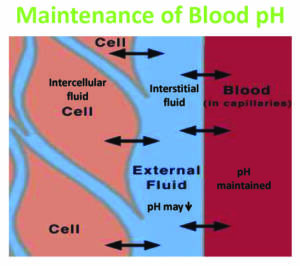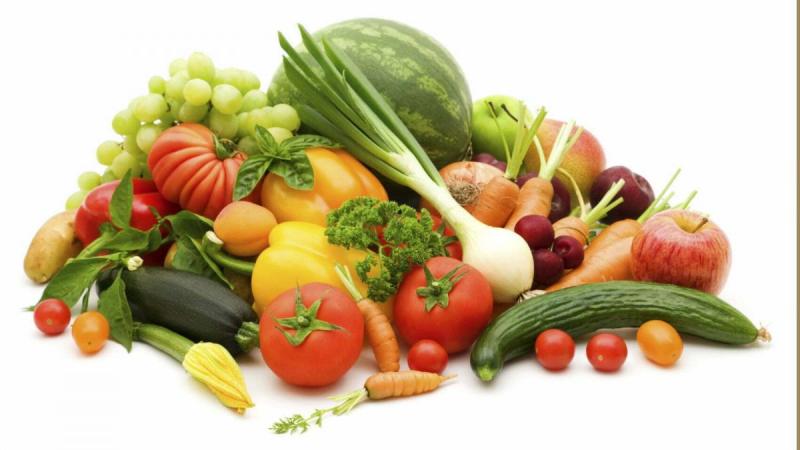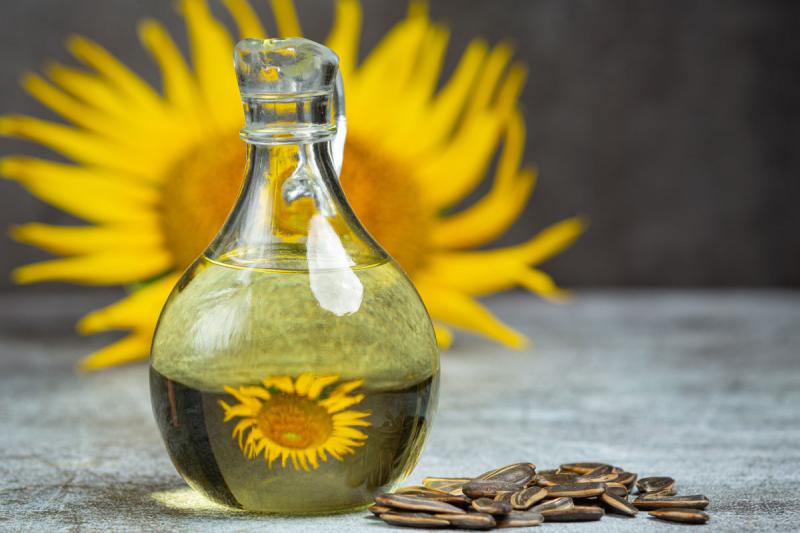Our body must maintain a precise balance of acidity and alkalinity to function properly and maintain good health. In today’s obesogenic world, many factors such as type of foods consumed, over usage of medicines, lifestyle and even stress can disrupt this balance making us more vulnerable to diseases.
pH scale shown above, depicts how acidic or alkaline our body is. The scale ranges from 0 to 14, with pH value 7 as neutral, a pH value less than 7 acidic and a pH value greater than 7 alkaline.
pH of various Body Tissues and Fluids
Every tissue of the body functions best within a certain pH range. In different tissues, this optimal range is different.
| Body Tissue | Normal pH | Nature | Effect of pH |
| Stomach | 1.2 – 3.0 | Very acidic | Helps in digestion of food and destroys any harmful germs that may enter the stomach |
| Skin | 4.0 – 6.5 | Acidic | Protects the body against germs in the environment |
| Urine | 4.5 – 8.0 | Slightly acidic | The average value for urine pH is 6.0 |
| Saliva | 6.3 – 6.8 | Slightly acidic | Food and drink change the pH level of saliva |
| Arterial Blood | 7.32 – 7.42 | Slightly alkaline |
pH is maintained in different tissues in the body using primarily three mechanisms: buffer systems, respiratory control and control by kidneys.
The pH of human blood is strictly maintained, as even slight changes outside the normal range would be injurious to health. The pH of saliva and urine change depending on diet, body metabolism & relevant factors. However, even when the pH of these fluids’ change, the pH of blood remains constant.
Source of acid in the body
The body is subjected to acid in two ways
- Body’s functioning –The body’s normal functioning continuously produces hydrogen ions and CO2 both of which reduce the pH, making it acidic. Acid is also produced by the body when certain foods are broken down.
- Diet – When a food is eaten, digested and absorbed, it creates either acidic or alkaline by-products. Research has come out with data on Acid / Alkaline foods with Potential Renal Acid Load (PRAL) as the basis. The PRAL of a particular food is the amount of acid that is expected to reach the kidneys after the food is digested and absorbed. Diets which are high in meat, cereals, processed foods and low in fruits and vegetables produce a net acid load on the body.
Acid Alkaline Balance
The body has various compensatory mechanisms to maintain the pH of blood within the desirable range.
Lungs – adjust the blood pH upward by exhaling CO2 from the body.
Kidney – adjust blood pH through excreting H+ ions in the urine and by conserving bicarbonate ions (a base which neutralizes the acids).
The regulation of pH value inside and outside the cell is essential for the various metabolic processes in the body. This regulation is done by exchange of fluids inside the cell, extracellular fluid and blood. If the acid load on the body continues, then to maintain the blood pH, the extracellular fluid becomes acidic causing undesirable changes in the body.

If the extracellular fluid remains acidic for a longer period of time it leads to inflammation and reduced immunity making the body susceptible to various diseases. Avoid the in between stage of extracellular fluid acidosis as far as possible or to reduce its duration follow an appropriate diet and regular physical activity. This will help to maintain the pH of body fluids and avoid unhealthy body conditions.
Effect of increased acid load or Extracellular acidosis
Blood has its own compensatory mechanism which becomes insufficient if there is excessive acidic load on the body over prolonged periods. The following consequences may occur:
- Bone: Release of calcium and magnesium from the bone, to neutralize the acid and maintain the blood’s pH. Over time, borrowing of calcium from the bone can make the bones weak leading to osteoporosis.
- Kidney: There is an increase in the urinary excretion of phosphorus, chloride and sodium and increase in the reabsorption of citrate in the kidney, making the urine more acidic. These changes increase the risk of kidney stone formation.
- Insulin Resistance: Reduction in the binding capacity of insulin to the cell receptor, causes insulin resistance and increases the risk of Diabetes
- Inflammation: Inflammation of cells reduces body’s immunity.
Some conditions that may increase acid production in the body are:
- Uncontrolled Diabetes
- Starvation
- Asthma
- Sleep apnea
- Overuse of sleeping pills
- Severe diarrhea
- Excessive alcohol intake without accompanied food
- Use of certain diuretics
- Exercising vigorously for a very long time
- Retention of urea and uric acid by the body
Aging & pH
As we age our blood pH becomes acidic as there is reduced kidney function and reduced acid excretion.
Symptoms of Latent Acidosis
- Low energy
- Headache & confusion
- Fatigue
- Muscle weakness
- Sleepiness
- Lack of appetite
Symptoms of Latent Alkalosis
- Nausea
- Numbness
- Muscle twitching
- Hand tremors
- Prolonged muscle spasms
Positive Role of Healthy Lifestyle for Disease Prevention
Maintaining the pH of our body through Diet
Research has come out with data on Acid / Alkaline foods with Potential Renal Acid Load (PRAL)as the outcome of the food after digestion and absorption
Acid producing foods – positive PRAL score
Alkaline producing foods – Negative PRAL score
Neutral Foods – 0 PRAL score
Average PRAL scores of different food groups based on 100 gm food.
| Food Group and Foods and their PRAL scores based on 100 gm/ ml food | PRAL Score |
| Meat and Meat Products Average | + 9.5 |
| Fish | + 7.9 |
| Milk, Dairy, and Eggs
Milk Low protein cheese High protein cheese |
+ 1.0
+ 8.0 + 23.6 |
| Sugar and Sweets | + 4.3 |
| Vegetables | -2.8 |
| Fruits, Nuts, and Juices | -3.1 |
| Grain Products
Bread Flour Noodles |
+ 3.5
+ 7.0 + 6.7 |
| Legumes | + 1.2 |
| Fats and Oils | 0 |
*This table is adapted from the Remer and Manz study and each PRAL score is based on a 100g portion of food.
Detailed List of Foods with their PRAL score
Food Exchange Plan and PRAL for 1500 Kcal Vegetarian diet.
Carbohydrate – 60-65% Protein – 18-20% Fat – 20-25 %
| Food Group | Exchange | Quantity | Household measure | Energy (Kcal) | Protein (gm) | PRAL for the diet | Av PRAL / 100 gm |
| Milk (skimmed) |
3 | 930 ml | 2 cup milk
( 250 ml each) + 2 katori curd from skim milk (200 gm each) |
279 | 24 | + 9.3 | + 1.0 |
| Pulse | 2.5 | 75 gm | 2 katori dal + a handful of bhuna chana ( 15 gm) or ½ katori sprouts ( 35 gm) |
250 | 18 | + 2.6 | + 3.5 |
| Cereal | 6 | 120 gm | 1 slice
whole wheat bread + 20 gm Dalia/ Oats/ Suji + 4 chapati or 2 chapati + 1 Katori rice |
420 | 15 | + 10.8 | + 8.4 |
| Veg A | 2 | 200 gm | Spinach/ Sarson ka saag/ Lettuce/ Bathua/ Ghia/ tinda/ tori |
24 | – | -5.6 | -2.8 |
| Veg B | 4 | 400gm | 2 Katori cooked vegetable + 2 plate salad |
144 | 8 | -11.2 | -2.8 |
| Fruit | 3 | 300gm | ½ medium apple + 1 orange / ½ banana + 1 small guava / 2 slices pineapple |
120 | – | -9.3 | -3.1 |
| Fat | 3 | 15gm | 3 tsp | 135 | – | 0 | 0 |
| Sugar | 2 | 10gm | 2 tsp | 40 | – | neg | -0.1 |
| Sunflower seeds | 5gm | 1 tsp | 30 | 1.5 | + 0.6 | + 12.1 | |
| Almonds | 8 no. | 8 no. | 54 | 2.0 | + 0.2 | + 2.3 | |
| Walnuts | 2 no. | 2 no. | 54 | 1.2 | + 0.3 | +6.8 | |
| TOTAL | 1550 | 69.7 | –3.8 |
Net PRAL of the above 1500 Kcal Vegetarian diet plan is – 3.8
Food Exchange Plan and PRAL for 1500 Kcal Non-vegetarian diet
| Food Group | Exchange | Quantity | Household measure | Energy (Kcal) | Protein (gm) | PRAL for the diet | Av PRAL / 100 gm |
| Milk ( skimmed) | 3 | 930 ml | 2 cups
milk ( 250 ml each) + 2 katori curd from skim milk ( 200 gm each) |
279 | 24 | +9.3 | +1.0 |
| Pulse | 2.5 | 75 gm | 2 katori dal + a handful of bhuna chana (15 gm) or ½katori sprouts (35 gm) |
250 | 18 | +2.6 | +3.5 |
| Egg/ Chicken/Fish | 1 | 40 gm | 1 egg/ 100gm chicken or fish |
70 | 7 | +3.8 | +9.5 |
| Cereal | 6 | 120 gm | 1 slice
whole wheat bread + 20 gm Dalia/ Oats/ Suji + 4 chapati or 2 chapati + 1 Katori rice |
350 | 12.5 | +7.0 | +7.0 |
| Veg A | 2 | 200 gm | Spinach/ Sarson ka saag/ Lettuce /Bathua/ Ghia/ tinda/ tori |
24 | – | -5.6 | -2.8 |
| Veg B | 4 | 400gm | 2Katori cooked vegetable + 2 plate salad |
144 | 8 | -11.2 | -2.8 |
| Fruit | 3 | 300gm | ½ medium apple + 1 orange / ½ banana + 1 small guava / 2 slices pineapple |
120 | – | -9.3 | -3.1 |
| Fat | 3 | 15gm | 3 tsp | 135 | – | 0 | 0 |
| Sugar | 2 | 10gm | 2 tsp | 40 | – | neg | -0.1 |
| Sunflower seeds | 5gm | 1 tsp | 30 | 1.5 | +0.6 | +12.1 | |
| Almonds | 4 no. | 4 no. | 27 | 1.0 | +0.1 | +2.3 | |
| Walnuts | 2 no. | 2 no. | 54 | 1.2 | +0.3 | +6.8 | |
| TOTAL | 1523 | 73.2 | +23.7
-26.1 Net –2.4 |
Net PRAL of the above 1500 Kcal Non-Vegetarian diet plan is -2.4
Thus, analysis of our daily food intake can help us to determine whether the day’s meal’s net effect is acidic, alkaline or neutral and modifications can be made accordingly so that the net effect is alkaline, avoiding in-between stages of extracellular acidosis.
Since grains, legumes, dairy and meat all are acid producing they should be combined with fruits and vegetables to make the net effect of the day’s meal either neutral or alkaline.
Physical Activity
Regular physical activity helps to improve blood circulation in hand and feet which in turn help to move H+ from cells into the circulation for excretion. It also improves the ability to balance the acids in muscles and blood. The time and intensity of the physical activity should be increased gradually. Strenuous exercises should be avoided to prevent acid formation and accumulation in the muscles.



